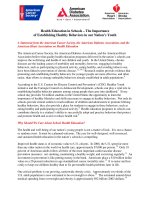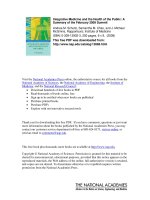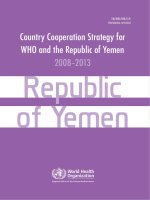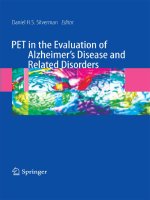Opportunities for Change: Improving the Health of American Indians/Alaska Natives in Washington State docx
Bạn đang xem bản rút gọn của tài liệu. Xem và tải ngay bản đầy đủ của tài liệu tại đây (1.17 MB, 78 trang )
OpportunitiesforChange:
Improving the Health of
American Indians/Alaska Natives
in Washington State
AmericanIndianHealthCareDelivery
Plan
2010‐2013
April2010
American Indian Health Commission for
Washington State
Acknowledgements
Publicationofthe2010–2013AmericanIndianHealthCareDeliveryPlanwouldnothave
beenpossiblewithoutthecontributionsandsupportofthefollowingorganizations:
TheAmericanIndianHealthCommissionofWashingtonState
TheWashingtonStateDepartmentofHealth
TheUrbanIndianHealthInstitute–SeattleIndianHealthBoard
Northwest
PortlandAreaIndianHealthBoard
Thefollowingservedaseditors,contributors,andprovideddraftingassistance:
AmericanIndianHealthCommissionOralHealthCareWorkgroup
AmericanIndianHealthCommissionMaternal‐InfantHealthWorkgroup
AmericanIndianHealthCommissionMentalHealthWorkgroup
AmericanIndianHealthCommissionLong‐TermCareWorkgroup
AmericanIndianHealthCommissionExecutiveCommittee
SherylLowe,executivedirector,
AmericanIndianHealthCommission
KrisLocke,ruralhealthconsultant,AmericanIndianHealthCommission
KrisSparks,DepartmentofHealth’sOfficeofCommunityHealth
Systems/RuralHealth
ZeynoShorter,PhD,ruralhealthepidemiologist,DepartmentofHealth
JenniferSabel,PhD,injuryepidemiologist,DepartmentofHealth
NancyAnderson,MD,MPHFaculty,EvergreenStateCollege
Laurie
Cawthon,MD,WashingtonStateDepartmentofSocialandHealth
Services
JoseliAlves‐Dunkerson,DDS,manager,DepartmentofHealthOralHealth
Program
JosephCampo,WashingtonStateOfficeofFinancialManagement
RalphForquera,executivedirector,SeattleIndianHealthBoard
RachelBrucker,epidemiologist,UrbanIndianHealthInstitute
AlicePark,epidemiologist,UrbanIndianHealthInstitute
JimRoberts,policyanalyst,NorthwestPortlandAreaIndianHealthBoard
JoshuaD.Jones,MD,epidemiologist,PortlandAreaIndianHealthServices
AMERICANINDIANHEALTHCOMMISSIONmembers:
ChehalisTribe ColvilleConfederatedTribes CowlitzIndianTribe
JamestownS’KlallamTribe KalispelTribe LowerElwhaKlallamTribe
LummiTribe MakahTribe MuckleshootTribe
N.A.T.I.V.E.Project NooksackTribe PortGambleS’KlallamTribe
PuyallupTribe QuinaultNation QuileuteTribe
SamishNation Sauk‐SuiattleIndianTribe SeattleIndianHealth
Board
ShoalwaterBayTribe SkokomishTribe SnoqualmieNation
SpokaneTribe SquaxinIslandTribe StillaguamishTribe
SuquamishTribe SwinomishTribe TulalipTribe
UpperSkagitTribe
AmericanIndianHealthCareDeliveryPlan2010‐2013
TableofContents
LetterfromChairwomanScottandSecretarySelecky
Page
I. ExecutiveSummary 2
II. HealthDisparitiesandServiceDelivery 7
A. TheAmericanIndianHealthCareDeliveryPlan 7
B. TheAmericanIndianHealthCommission:ATribal‐stateModelof
Collaboration 8
C. TheIndianHealthDeliverySystem……. 9
D. UrbanIndian
HealthPrograms 15
E. HealthDisparitiesandAmericanIndians/AlaskaNativesinWashington 20
III. OpportunitiesforChange 23
A. State‐Tribal‐UrbanIndianHealthCollaborative 23
B. IndianHealthDataCollaboration 25
C. National,Tribal,andstateHealthReform 26
IV. 2007–
2009IndianHealthAccomplishments 29
V. 2009–2011GoalsandObjectives 31
1 TribalForumforImprovingAI/ANHealth 31
2 ImprovedMaternalandInfantHealth 34
3 Long‐TermCareDeliverySystemsinIndianCountry 37
4 OralHealthCareAccess 39
5 AI/ANAccesstoMentalHealthServices 49
VI. TribalHealthProgramsinWashingtonState 56
Attachments
A:AcronymsReference
Opportunities for Change: Improving the Health of AI/ANs in WA State Page 1
2010-2013 American Indian Health Care Delivery Plan
OpportunitiesforChange:
“Formorethanfourteenyears,Congresshasfailedto
reauthorizetheIndianHealthCareImprovementActand
comprehensivelymodernizeNativeAmericanhealthcare
services.Thisisunfairandunacceptable.
Today’sNativeAmericansaredisproportionatelysuffering
fromdebilitatingillnesses,likediabetes,heartdiseaseand
stroke.Theinfantmortalityrateis
150percenthigherfor
NativeAmericaninfantsthanwhiteinfants,andthesuicide
rateforNativeAmericansistwoandahalftimesthenational
rate.Withthesealarmingstatistics,improvementstoNative
Americanhealthcarecouldnotcomeatamoreurgenttime.”
‐ThenSenatorBarackObama
January18,2008;U.S.SenateFloor
Opportunities for Change: Improving the Health of AI/ANs in WA State Page 2
2010-2013 American Indian Health Care Delivery Plan
I. ExecutiveSummary
TheAmericanIndianHealthCareDeliveryPlan(hereinafterreferredtoas“theplan”)is
acollaborativeeffortbetweenWashingtonStateDepartmentofHealth,theAmerican
IndianHealthCommissionforWashingtonState(AIHC),andWashingtonStateTribes.
Since1997theplananditssubsequentupdateshasservedasaframeworkfor
Tribes,
UrbanIndianHealthOrganizations(UIHO),thecommission,andWashingtonState
(hereinafterreferredtoas“thestate”)toaddressasharedgoalofimprovingthehealth
statusofAmericanIndian/AlaskaNativepeople(AI/AN).Overthepast12yearsmuch
hasbeenaccomplished,yetmoreworkremains.WhiletheoverallhealthofAI/ANs
slowlyimprovesovertime;thesignificantgapinhealthoutcomesbetweenAI/ANand
otherpopulationshasnotsignificantlychanged.
Today,thestate,Tribes,andUrbanIndianHealthOrganizationsfaceextraordinary
challengesinproactivelyaddressinghealthissuesastheygrapplewiththeimpactsofa
nationalrecessionunlikeanyseeninmanyyears.Whilethesechallengesaredaunting,
theyalsopresentuniqueopportunitiestoredefinetheapproachesusedtoaddress
Indianhealthdisparitiesandtoimprovecollaborationacrossmultiplesystems,
governments,organizations,infrastructures,andpolicies.Leadershipandpartnerships
aremoreimportantthanever,notonlytosurvivethecurrentcrisis,buttocontinue
movingforwardwiththecomplexworkinaddressinghealthdisparitiesandwisely
leveraginglimitedresourcesavailabletodoso.
Overthenextfouryears,Tribes,theAmericanIndianHealthCommission,Department
ofHealth,theGovernor’sOffice,theWashingtonStateHealthCareAuthority(HCA),and
WashingtonDepartmentofSocialandHealthServices(DSHS)willworktoaddress
tribally‐identifiedpriorityhealthissuesincollaborationwithotherstateagenciesand
stakeholdersthatsharesimilargoals.Atthesametime,amoretargetedeffortwillbe
launchedtodeterminethetrueextentofhealthdisparitiesfortheoverallstateAI/AN
populationinthe21
st
century.Throughamoresystematicassessmentofthecurrent
healthstatusofAI/ANandtheenvironmentsandsystemsinwhichTribalhealth
programsfunctiontoday,wecanbegindevelopingastronger,strategicframeworkfor
addressingfuturepriorityareas.Theultimategoaloftheseeffortsistoclosethegap
between
goodhealthoutcomesandincreasedmortalityforWashington’sAI/AN
populationanddevelopmorecomprehensiveservicesinTribalcommunities.
Opportunities for Change: Improving the Health of AI/ANs in WA State Page 3
2010-2013 American Indian Health Care Delivery Plan
InSectionI,HealthDisparitiesandServiceDelivery,amoredetailedlookattheplan
anditshistoryisprovidedinordertoemphasizeitsimportanceinon‐goingtribal‐state
workonIndianhealthissues.Theplan,mandatedbytheWashingtonLegislaturein
1995,isanimportantblueprintforaddressingthepoorhealthstatusofAmerican
IndianandAlaskanNativesinacollaborativeandstrategicmanner.
Theplanisdevelopedthroughaunique,Tribally‐drivenprocess.Everyotheryear,
AmericanIndianHealthCommissionhostsaTribalLeadersHealthSummittoshape
strategiesforaddressingidentifiedpriorityhealthissuesonwhichthecommissionwill
workoveratwo‐tofour‐yearperiodoftime.Triballeadersandcommissiondelegates
definethosepriorityareaspriortothesummit,andAIHCcreatesworkgroupsaround
eachtopic,workgroupsthatincludeTriballeaders,Tribalhealthproviders,Tribalhealth
policyexperts,AIHCdelegates,stateleadersandstatehealthexperts.Workgroups
developdraftpositionpapersonthepriorityissuesidentifiedwithrecommended
strategiesonhowtoresolvetheissuescollaboratively.Thepapersarepresentedand
discussedatthesummits,revisedandapprovedbytheAIHCdelegates.Thesepapers
serveastheframeworkforsubsequentplans.
AIHCismorethoroughlydiscussedinSectionIforitsuniquenessasastate‐Tribal
modelforhealthcollaboration.AIHC’smissionistoimprovethehealthofAI/ANpeople
throughtribal‐statecollaborationonhealthpoliciesandprogramsthatwillhelp
decreasedisparities.Thecommissioncontinuestoserveasaneffectiveforumfor
achievingunityandguidingthecollectiveneedsofTribalgovernmentsandurban
Indianhealthprogramsinprovidinghigh‐quality,comprehensivehealthcaretoAI/ANs
inWashington.
SectionIalsodescribestheexistingIndianhealthcaredeliverysystem.Thefederal
government’sobligationtoprovidehealthcareservicestoAI/AN,explicitinsome
treaties,hasbeensetforthinaseriesoffederallaws,executiveordersandcourt
decisions.ThelandmarkSnyderActof1921,wasthefirsttimeCongressenacted
legislationpermanentlyauthorizingappropriationsforAmericanIndianhealthcare.In
presentday,theIndianSelf‐DeterminationandEducationAssistanceActof
1975(P.L.
93‐638)–authorizingthefederalIndianHealthService(IHS)toturnoverfull
administrativeresponsibilityforIHSprograms,throughcontracts,totribesupontheir
request‐andtheIndianHealthCareImprovementActof1976(P.L.94‐437)–
authorizingaseriesofhealthprogramsbasedona“community
healthmodel”
approachanddirectingincreasedappropriationsforsuchprograms–andtheir
subsequentamendments,nowguidethedeliveryofhealthservicestoIndianpeople.
TribescanoperatehealthprogramsthroughTitleIofP.L.93‐638andcontractwithIHS,
Opportunities for Change: Improving the Health of AI/ANs in WA State Page 4
2010-2013 American Indian Health Care Delivery Plan
orunderTitleIII,andentercompactswiththefederalgovernmenttoassumefull
responsibilityforhealthprograms.Indianhealthprogramsprovideprimary,
environmental,community,andcontracthealthservicesthroughprogramseither
operatedbythefederalgovernmentthroughtheIHS,bylocaltribalgovernment,orby
urbanIndianhealthorganizations.The
systemiscomplexyetimportanttounderstand
inthecontextofIndianhealthstatustoday.
SectionIalsodescribesingreaterdetailtheUrbanIndianProgramanditsdelivery
system.ManyAI/ANliveinurbanareasandarenoteligibleforhealthservicesinthe
samewayinwhichreservation‐
basedAI/ANare.UrbanIndianProgramswarrant
attentionastheseservicesareseverelyunderfundedandtheneedsareasgreatas
thoseforreservation‐basedIndianpeople.
IndianhealthdisparitiesarealsoexploredinSectionI.AlthoughAmericanIndians
compriseonlyabouttwopercentofWashington’spopulation,theirsignificanthealth
careneedsanduniquelegalstatuswarrantpublicattention.AmericanIndianand
AlaskanNativesinWashingtonexperiencedisproportionatelyhighmortalityand
morbiditycomparedtothegeneralpopulation.Datafrom2003‐2007indicatethat
AI/ANshavethehighestmortalityratesforallcausesthananyotherpopulationinthe
state,
1
withspecificcausesincludingbutnotlimitedtosuicide,injury,chronicliver
disease,ChronicObstructivePulmonaryDisease,andheartdisease.
WhileprogresshasbeenmadeinimprovingthehealthofAI/ANoverthelast30years,
thegapinhealthoutcomesremains.Atargetedcommitmentandeffortisneededin
ordertoensurethisgapiseliminated.ThestateandTribeswillworktogetherto
implementeffectivepublichealthprograms,diseasepreventionandtreatment
strategies,andpursueadequatelevelsofresources,bothfinancialandprofessional.
Theongoinggovernment‐to‐governmentrelationshipcontinuestoraisetheissueof
improvingthestatusofAmericanIndianandAlaskanNativesasamutualpriority.
SectionII,OpportunitiesforChangedescribesthreeinitiativesthatprovidethe
potentialforfurtherreducingAI/ANhealthdisparitiesanddevelopingpoliciesthat
improvetheabilityofTribestoprovideneededservicesintheircommunities.Withthe
economicchallenges
wefacealsocomeopportunitytorethinkourapproachesto
overallimprovedhealth,andinparticular,Indianhealth.Duringthistime,thereare
opportunitiesforclearlyformulatingasharedvisionandmissionandtoimplement
strategiesthatlookbeyondthecrisisoftoday.
1
WashingtonStateVitalStatistics2006.AnnualReport.CenterforHealthStatistics,Olympia,WA.
January2009
Opportunities for Change: Improving the Health of AI/ANs in WA State Page 5
2010-2013 American Indian Health Care Delivery Plan
First,aState‐Tribal‐UrbanIndianHealthCollaborativehasbeenre‐institutedata
state/triballeaderpolicylevelforaddressingappropriatesystemschangeandpolicy
decisionsthatneedtobemadetochangehealthoutcomesforIndianpeople.This
group—comprisedoftribalgovernments,healthstaff,andstateleadersacross
multiplesystemsanddepartments—willbestrategicallyaligningstatewideIndian
healthdisparitiesworkwithGovernorGregoire’s5‐PointHealthCareInitiative.Thiswill
allowthegrouptoleverageexistingresources,maximizethelimitedfundscurrently
available,andcreatetheinfrastructurenecessarytofurtherreduceIndianhealth
disparitiesinthefuture.
Second,severalagencies,organizations,andinstitutionshaveexpressedarenewed
interestincomingtogethertodevelopamorecompletesetofAmericanIndianhealth
statusdata.Accuratedataisnecessarytosupportcommunityhealthassessmentsand
policydevelopmenttoimproveservicedeliveryandhealthstatusofIndianpeople.
WithoutpaintingamorethoroughpictureofIndianhealthinWashingtontoday,the
abilitytoplanorimproveservices,monitorquality,andanalyzecostsisseverely
impaired.Tribalgovernmentsmustbeintricatelyinvolvedinsucheffortstoassurethe
useofthedataisculturally‐appropriate,acceptable,andmeaningfulinimprovingthe
healthoftheirpeople.Byreinstitutingeffortsthatbeganin1997betweenthe
AmericanIndianHealthCommissionandWashingtonStateDepartmentofHealth
throughanAmericanIndianDataCommittee,anupdatedframeworkcanbedeveloped
foraddressingpriorityhealthissuesforAI/AN.
Third,sweepingnationalhealthreformandthecurrentadministrationofferaunique
opportunityforchangeinhowhealthcareisprovidedtoAI/ANs.AsIndianhealth
leadershipsuchastheU.S.IndianHealthServices,theNationalIndianHealthBoard,
andmoreregionally,theNorthwestPortlandAreaIndianHealthBoard,strongly
advocatesfortheinclusionofIndianhealthreforminnationalreformstrategies,the
stateisalsorethinkinghowitprovidesquality,affordable,andcost‐effectivehealth
caretoitscitizens.Thestate,Tribes,andthecommissionwillactivelypartnerinthese
effortstoaddresstheneedforAI/ANincreasedaccesstoexistingservices,increased
Tribalproviderreimbursementopportunitiesso
culturally‐appropriateservicescanbe
providedinTribalcommunities,anddevelopmechanismsforevaluatingprogressfor
improvedIndianhealthstatus.
SectionIII,2007‐2009Accomplishments,highlightssomeofthemajorachievements
madeforIndianhealthinthestatesincethelastplanwaspublishedin2007.Additional
partnershipshavebeendeveloped,keypolicyissueshavebeenaddressed,andthere
Opportunities for Change: Improving the Health of AI/ANs in WA State Page 6
2010-2013 American Indian Health Care Delivery Plan
areanincreasednumberofTribalrepresentativesservingonrelevantstate
committeesandtaskforces.
SectionVI,GoalsandObjectives,identifiesthepriorityissueareastargetedtobe
addressedoverthenextfouryears.ThegoalsarethosethatAIHC,Tribes,UrbanIndian
HealthOrganizations(UIHO),andthestatewillworktogetherontofurtherthemission
ofeliminatingIndianhealthdisparities.Thefirstcomponent,TribalForumfor
ImprovingAI/ANHealth,focusesonstrategiestostrengthenthecollectivevoicefor
TribesandUrbanIndianHealthProgramstogreaterinfluencehealthpolicyandassure
fullaccessbyAI/ANstohealthservicesandprogramsinthestate.Thisgoalalso
includeseffortstodevelopandimplementstrongerstrategiesforaddressingIndian
healthdisparitiesandthedevelopmentofmoreeffectivecommunicationavenues
betweenTribesandthestatesoTribesareawareofemergenthealthnews,
information,andopportunities.Whileplansinthepasthaveservedwellininforming
individuals,Tribes,andorganizationsonthepoorstatusofIndianhealthand
identifyingpolicyworkbeingaccomplished,furthercollaborativeconversationsand
effortsacrosstribes,systems,organizations,andresearchinstitutionsmustbepursued
tostrategicallyaddressthesedisparities.Thiscomponentoutlineshowthatmight
begintobeaccomplishedoverthenextfouryears.
Thefourhealthpriorityareas—Maternal‐InfantHealth,Long‐TermCare,OralHealth,
andMentalHealthservices—wereidentifiedatthe2008TribalLeadersHealth
Summitandserveastheareasofdisparitiesfromwhichthebroaderworkdescribed
abovecouldbeshaped.Eachpriorityareaincludes:(a)Goalstatement;(b)Problem
statement;(c)Anysupportingdata;and(d)Strategies(objectives)foraddressingthe
problem.ThestrategiesarerecommendationsdevelopedinAmericanIndianHealth
CommissionpositionpapersattheTribalLeadersHealthSummitinNovember2008
andsubsequentlyapprovedbycommissiondelegatesin2009.Atargetedfocusinthese
fourpriorityTribalhealthareaswillallowustonotonlydevelopsolutionstothese
specificproblems;itwillalsoserveasawaytofurtherdefinetheprocessbywhich
additionalIndianhealthdisparitiescanbeaddressedinthefuture.Thestrategies
identifiedin
thissectionwillbepursuedbasedonresourceavailabilityineacharea.
Thefinalsection,TribalHealthProgramsinWashingtonState,providesspecific
informationaboutexistingTribalandUrbanIndianhealthprogramsandclinics.Italso
providesinformationaboutthetypesofservicethatareprovidedbyeachsitein
order
tocompletetheprofileoftheIndianhealthdeliverysysteminourstate.
Opportunities for Change: Improving the Health of AI/ANs in WA State Page 7
2010-2013 American Indian Health Care Delivery Plan
Manyopportunitiesforchangeexistinthecurrentenvironment.Overthenextfour
years,Tribes,AIHC,andpartnershavetheopportunitytoidentifyandimplementnew,
moreimpactfulwaysofaddressingthehealthofIndianpeople.The2010‐2013
AmericanIndianHealthCareDeliveryPlanisaguideforfurtheringthateffortandfor
achievinghealthyoutcomesandcomprehensive,culturallyappropriatehealthservices
forAmericanIndians/AlaskaNativesinWashington.
II. HealthDisparitiesandServiceDelivery
A. AmericanIndianHealthCareDeliveryPlan
TheWashingtonStateHealthServicesActof1993originallyauthorizedtheAmerican
IndianHealthCareDeliveryPlan.In1995,responsibilityfortheplanwastransferred
fromtheHealthCareAuthoritytotheDepartmentofHealth,whichallocatedfundsto
developtheplan.
ThepurposeoftheplanasstatedinRCW43.70.590wasto:
(make)recommendationstoprovidersandfacilities’methodsforcoordinatingand
jointventuringwiththeIndianhealthservicesforservicedelivery
(find)methodstoimproveAmericanIndianspecifichealthprogramming,and;
(create)co‐fundingrecommendationsandopportunitiesfortheunmethealth
servicesprogrammingneedsofAmericanIndians
Aseparatelaw,RCW43.70.052(4)alsodirectedtheDepartmentofHealth“in
consultationandcollaborationwiththefederallyrecognizedtribes,urbanorother
Indianhealthserviceorganizations,andthefederalareaIndianhealthservice,(to)
design,develop,andmaintainanAmericanIndian‐specifichealthdata,statistics
informationsystem.Thedepartmentrulesregardingconfidentialityshallapplyto
safeguardtheinformationfrominappropriateuseorrelease.”
ThefirstplanwaspublishedinJuly1997,markingthebeginningofasignificant
partnershipbetweenWashington’sTribesandDepartmentofHealthtoidentifyand
addresshealthdisparitiesaffectingAmericanIndiansandAlaska
Natives.Anadvisory
groupwascreatedtodevelopthefirstplan,comprisedofAmericanIndianandnon‐
Indianhealthcareprovidersandrepresentativesoftribal,state,andlocal
organizations.Thethreeprimaryplanobjectivessetforthbythisgroupaptlydescribe
thepremiseoftheplantoday:
Opportunities for Change: Improving the Health of AI/ANs in WA State Page 8
2010-2013 American Indian Health Care Delivery Plan
1. UnderstandthehealthstatusofAmericanIndiansinthestate
2. Developstrategiestoimprovetheirhealthstatus
3. Closegapsintheprovisionofhealthcareservices
Theplanhasbeentheresultofactivecollaborationbetweentribes,tribal
organizations,andthedepartment.Ithasalsohelpedtosparkadditionalcollaboration
withotherstateagenciesandvariouspublicandnon‐profitentitiesinWashington.
Whiletheplanseekstoprovideacomprehensiveoverviewoftheprogress,
opportunitiesandchallengesthattribesandthestatefaceineliminatinghealth
disparitiesaffectingWashington’sAI/ANpopulation,itbynomeansisasubstitutefor
thegovernment‐to‐governmentrelationshipthatexistsbetweenfederallyrecognized
Tribesandstategovernment.Throughtheauspicesofthecommission,tribescontinue
tobethedrivingforceintheplan’scontentandscope.
B. TheAmericanIndian HealthCommissionforWashingtonState
AmericanIndianHealthCommissionwascreatedin1994byfederallyrecognizedtribes,
UrbanIndianhealthorganizations,andotherIndianorganizationstoprovideaforum
foraddressingTribal‐statehealthissues.Thecommission’smissionistoimprovethe
healthofAI/ANpeoplethroughtribal‐statecollaborationonhealthpoliciesand
programsthatwillhelpdecreasedisparities.Thecommissionworksonbehalfofthe29
federally‐recognizedTribesand2UrbanIndianHealthOrganizationsinthestate.
DelegatesareofficiallyappointedbyTribalCouncilstorepresenteachindividualTribe,
andUrbanIndianHealthOrganizationrepresentativesserveasmembers‐at‐large.This
modelhasbeenpresentedinstate,regional,andnationalsettingsasaframework,or
tool,forothersintheirworkinformingstrongtribal‐statepartnershipsonhealthcare
issues.Thecommissioncontinuestoserveasaneffectiveforumforachievingunityand
guidingthecollectiveneedsofTribalgovernmentsandurbanIndianhealthprogramsin
providinghigh‐quality,comprehensivehealthcaretoAI/ANsinWashington.The
ultimategoalinpromotingincreasedTribal‐statecollaborationistoimprovethehealth
statusofAmericanIndiansandAlaskaNativesbyinfluencingstateandTribalhealth
policyandresourceallocation.Keyactivitiesinclude:
• Identifyinghealth
policyissuesandadvocatingstrategiestoaddressTribalconcerns
• Coordinatingpolicyanalysis
• SolicitingandcollectinginformationfromthestateforTribalreviewandresponse
• DisseminatinginformationtoTribalhealthprogramsandleaders
• Promotingthegovernment‐to‐governmentrelationshipbetweenTribesandstate
healthagencies
Opportunities for Change: Improving the Health of AI/ANs in WA State Page 9
2010-2013 American Indian Health Care Delivery Plan
PleaseseeSectionV.A.forfurtherdetailsaboutthecommission.
C. TheIndianHealthServiceDeliverySystem
FederalgovernmentalresponsibilityforprovidinghealthservicestoAmericanIndians
datesbackmorethan200yearstotheassumptionofresponsibilityforIndian
educationand‘civilization.’LegalresponsibilityforAmericanIndianhealthtracesback
tomanyofthetreatiesenactedbetween1776and1858andtheirinclusionofmedical
careaspartialcompensationforthecedingoflandandotherresources.About30
treatiesspecifiedaccesstoaphysicianormedicalfacility,whileanequalnumber
merelycontainedgeneralclausespromisingassistancetothepoorandinfirm.Every
treatysignedbytribesinWashingtonincludedareferencetomedicalattendancetobe
defrayedbytheUnitedStates.Inmostcases,littlewasdonetomeettheseobligations.
2
TreatiesnegotiatedbytheUnitedStates,whichexchanged400millionacresofIndian
lands,createdatrustobligationfortheprovisionofhealthcareservicestoAI/ANs.This
solemnresponsibilityhasbeenaffirmedinnumeroustreaties,statutes,U.S.Supreme
Courtdecisions,andExecutiveOrders.
LegalbasisforAmericanIndianHealthCare
Overthepast85+years,thefederalgovernment’sobligationtoprovidehealthcare
servicestoAmericanIndiansandAlaskaNatives,explicitinsometreaties,hasbeen
explicitlysetforthinaseriesoffederallaws,executiveordersandcourtdecisions.
Amongthemostimportant:
SnyderActof1921–Congress,forthefirsttime,enactedlegislationpermanently
authorizingappropriationsforAmericanIndianhealthcare.Theactauthorizedthe
BureauofIndianAffairstoexpendfederalfundsandemployphysicians“forthe
reliefofdistressandconservationofhealth.”
JohnsonO’MalleyActof1934
–affirmedthefederalgovernment’sfinancial
responsibilityforIndianhealthservices,authorizingtheSecretaryoftheInteriorto
contactwithstateandlocalgovernmentsandprivateorganizationstoprovide
educational,medical,andotherassistancetoAmericanIndianswhonolongerlived
onthereservation.
TransferActof1954
–healthservicesforAI/ANwastransferredfromtheInterior
DepartmenttoanewlycreatedDivisionofIndianhealth(re‐titledtheIndianHealth
Service[IHS]in1955)undertheU.S.PublicHealthServiceintheDepartmentof
Health,EducationandWelfare.Primarymotivationforthetransferwastoimprove
2
AmericanIndianPolicyReviewCommission;ReportonIndianHealth:TaskForceSix‐IndianHealth.
WashingtonDC:USGovernmentPrintingOffice.1976
Opportunities for Change: Improving the Health of AI/ANs in WA State Page 10
2010-2013 American Indian Health Care Delivery Plan
qualityofmedicalservicestoAmericanIndiansthroughsupervisionbyanagency
withmoreadministrativeexpertiseandfundinginhealthcare.
IndianHealthFacilitiesActof1957–authorizedIHStocontributetothe
constructioncostsofcommunityhospitalsincaseswheresuchfacilitiescould
providebetteraccessandcarethanwouldthedirectconstructionofIndian
facilities.
IndianSanitationFacilitiesandServicesActof1959–expandedthescopeofIHS
programsbyauthorizingtheagencytoprovidesanitationfacilitiesincludingwater
supplies,drainageandwastedisposalforAmericanIndianhomes,communitiesand
lands.
IndianSelf‐DeterminationandEducationAssistanceActof1975
(P.L.93‐638)–
authorizedtheIHStoturnoverfulladministrativeresponsibilityforIHSprograms,
throughcontracts,toTribesupontheirrequest.
IndianHealthCareImprovementActof1976(P.L.94‐437,IHCIA)–authorizeda
seriesofhealthprogramsbasedon“communityhealthmodel”approachand
directedincreasedappropriationsforsuchprograms;includedfirstspecific
legislativeacknowledgementofthespecialfederalresponsibilityforAmerican
Indianhealthservices,establishedurbanIndianhealthprograms,andremoved
prohibitionofMedicaidandMedicarereimbursementstoIHSandTribally‐operated
facilities.
IndianHealthCareImprovementActAmendmentsof1992(P.L.102‐573)–
extendedTribalself‐governancetotheIHS;self‐governanceallowstribestoassume
responsibilityforresourcemanagementandservicedelivery,providinggreater
flexibilitytodesignanddevelopprogramsthatbettermeettheneedsofits
members,withnoabrogationofthefederalgovernment’strustresponsibility.
TheFederalIndianHealthService(IHS)
ThefoundationoftheIndianHealthServiceistoupholdthefederalgovernment’s
obligationtopromotehealthyAI/ANpeople,communitiesandculturesandtohonor
andprotecttheinherentsovereignrightsofTribes.Itsmissionis“toraisethephysical,
mental,socialandspiritual
healthofAI/ANstothehighestlevel”anditsgoalisto
“assurethatcomprehensive,culturallyacceptablepersonalandpublichealthservices
areavailableandaccessibletoAI/ANpeople.”
3
TheIndianHealthServicedelivery
systemwasdesignedtobeanintegrated,community‐basedsystemthatemphasizes
preventionandpublichealth,deliversandpurchaseshealthcareservicesandprovides
theinfrastructureforhealthimprovementsbybuildinghealthfacilitiesandsanitation
3
IndianHealthServices,IndianHealthServicesIntroduction,
/>
Opportunities for Change: Improving the Health of AI/ANs in WA State Page 11
2010-2013 American Indian Health Care Delivery Plan
systems,aswellasguaranteeinglong‐termimprovementthroughtraining,recruitment
andretentionofhealthpersonnel.Inadequateresources,however,createbarriersfor
theIndianhealthsystemtofullyachieveitsmission.
Thefollowingisexcerptedfromanarticle,“HealthDisparitiesChallengePublicHealth
AmongNativeAmericans”byJimRobertsandDr.JoshuaJones,publishedinthe2004
Fall/WintereditionoftheNorthwestPublicHealthJournalthatmorefullydescribesthe
Indianhealthdeliverysystemasitexiststoday
4
:
“TheAI/ANhealthcaredeliverysystemconsistsofapproximately594health
carefacilitiesacrossthecountry,including49hospitals,545ambulatory
facilities(231healthcenters,fiveschool‐basedhealthcenters,133health
stations,and176AlaskaNativevillageclinics).Thesehealthcarefacilitiescan
begroupedintothreecategories:
thoseoperateddirectlybyIHS,thoseoperated
bythetribesthroughaTribalHealthAuthority(THA)bycontractorcompact
withIHS,andthoseprovidingservicestourbanAI/ANs(individualsnotresiding
onornearanIndianreservation).
Alongwithambulatoryprimarycareservices,facilitiesmayofferinpatientcare,
medicalspecialties,traditionalhealingpractices,dentalcare,mentalhealth
care,eyecare,andsubstanceabusetreatmentprograms.Manytribesarealso
servedbycommunityhealth(e.g.,childhoodimmunizations,homevisits)and
environmentalhealth(e.g.,sanitation,injuryprevention)programs,whichmay
beadministeredbyIHSorTribes.Specialtyservicesandtypesofmedicalcare
thatarenotavailableatagivenfacilityareoftenpurchasedfromprovidersin
theprivatesectorthroughacontracthealthservice(CHS)program.TheIHSand
THAsapplystringenteligibilitycriteriatodeterminewhichpatientsqualifyfor
CHSfunding.TheseverelylimitedpoolofCHSdollarsalsomeansthatmostCHS
programslimitreimbursementtothosediagnosticortherapeuticservicesthat
areneededtopreventtheimmediatedeathorseriousimpairmentofthehealth
ofthepatient.Amongotherproblems,thisresultsinreducedaccesstoscreening
servicesandcontributestoincreasedcancermortality;forexample,accessto
breastcancerscreeningisaparticularproblemforNativewomen,withonly52
percentin2000reportingamammograminthepasttwoyears.
Corefundingofmostofthehealthservices(includingCHS)derivesfromIHS;
however,manyprogramsarealsodependentongrantfunding,tribalrevenue,
4
Roberts,JimandJones,Joshua.HealthDisparitiesChallengePublicHealthAmongNativeAmericans.Northwest
PublicHealthJournal:UniversityofWashingtonSchoolofPublicHealth&CommunityMedicine,Winter2004.
Opportunities for Change: Improving the Health of AI/ANs in WA State Page 12
2010-2013 American Indian Health Care Delivery Plan
andcollectionsfromthird‐partypayers(includingstateMedicaidprograms)to
remainfinanciallyviable.Morethan36percentofAI/ANfamiliesintheUnited
Statesmakinglessthan200percentofthefederalpovertylevelhadnohealth
insurance,apercentagesecondonlytoLatinos.
Alongwiththecommunityhealthprogramsassociatedwiththehealthcare
facilitiesineachcommunity,anincreasingnumberoftribesaretakinganactive
roleinpublichealthpracticeandresearchintheircommunity.Theseactivities
includegrant‐fundedcollaborationswithacademicresearchersandfederal
agencies(suchasapopulation‐basedBehavioralRiskFactorSurveillanceSurvey
specifictotribalcommunities)andactivecollaborationswithstateandcounty
healthdepartmentsinsuchareasasincreasingaccesstochildhood
immunizations.
Inaddition,thelastdecadehasseenamovetowardincreasingepidemiologic
capacitywithintriballyrunorganizations.IntheNorthwest,threetribally
operatedepidemiologycentershavebeenfoundedwithfundingfromIHSand
sustainedbygrant‐fundedactivities:theNorthwestTribalEpidemiologyCenter
attheNorthwestPortlandAreaIndianHealthBoard,servingthe43federally‐
recognizedtribesinIdaho,Oregon,andWashington(www.npaihb.org);the
AlaskaNativeEpidemiologyCenterattheAlaskaNativeHealthBoard
(www.anhb.org);andtheUrbanIndianHealthInstituteattheSeattleIndian
HealthBoard,whichfocusesonurbanIndiansnationally(www.uihi.org).The
workofthesetribalorganizationshasmadeprogressindocumentingthe
dramatichealthproblemsthatfaceNativecommunitiesintheNorthwest.
AlthoughthehealthcaresystemservingtheAI/ANpopulationmayseem
comprehensive,theprovisionofadequatehealthcaretoAI/ANsishamperedby
chronicunderfundingofIHSbytheUSCongress.
ThelackofadequatefundingtobothCHSprogramsandthedirectservices
providedbyIHSandtribalfacilitiesmeansthatuniversalaccesstocarefor
AI/ANsisfarfromareality.ItisestimatedthattheIHSisfundedatonly50
percentofitslevelofneed;someprograms,suchasmentalhealth,arefunded
ataslowas30percent.Therelationshipbetweenchronicunderfundingand
increasinghealthdisparitieshasbeenoutlinedintworecentreportsfromthe
U.S.CommissiononCivilRights.Thereportsconcludethatthestateofhealth
caredeliverytotheAI/ANpopulationisinastateofcrisis.Itseemslikelythatas
accesstocarebecomesevenmorelimitedduetoinadequatefunding,health
statusdisparitiesbetweenNativepeopleandthegeneralUSpopulationwill
Opportunities for Change: Improving the Health of AI/ANs in WA State Page 13
2010-2013 American Indian Health Care Delivery Plan
continuetowiden,andAI/ANswillcontinuetobedeniedopportunitiesfor
buildinghealthiercommunities.”
ThePortlandAreaIndianHealthService
ThePortlandAreaIndianHealthService(PAO)providesaccesstohealthcareforan
estimated150,000Indianresidentsofthe43federallyrecognizedTribeslocatedin
Idaho,Oregon,andWashington.Healthdeliveryservicesareprovidedbyamixof
healthcenters,healthstations,preventativehealthprograms,andurbanprograms.
Healthcentersprovideawiderangeofclinicalservicesandareopen40hourseach
week.Healthstationsprovidealimitedrangeofclinicalservicesandusuallyoperate
lessthan40
hoursperweek.Preventiveprogramsoffercounselorandreferralservices.
ThePortlandAreaIndianHealthServiceoperatessixfederalhealthfacilitiesinfive
TribalcommunitiesandoneatChemawaIndianSchool.Tribe’soperatehealthfacilities
undertheauthorityoftheIndianSelf‐DeterminationandEducationAssistanceAct
(PublicLaw93
‐638,asamended),TitlesIandV.
Twenty‐threeTribe’shaveTitleVcompactsandtherearetwenty‐fourTribe’sorTribal
organizationsthatcontractunderTitleI.Overall,Tribesadministermorethan74
percentofthePortland‐areabudgetauthorityappropriationthroughSelf‐
DeterminationcontractsorSelf‐Governancecompacts.Therearealsothreeurban
programswithservicesrangingfromcommunityhealthtocomprehensiveprimary
healthcareservices.Currentareasofemphasisare:
• InfantHealth
• HighRiskMaternalandChildHealth
• TobaccoUseIntervention
• DomesticViolence
• Diabetes
• Women'sHealthCare
• CancerScreening
NorthwestPortlandAreaIndianHealthBoard
TheNorthwestPortlandAreaIndianHealthBoard(NPAIHB)workscloselywiththe
PortlandAreaIndianHealthService.Establishedin1972,theboardisanon‐profittribal
advisoryorganizationservingthe43federallyrecognizedtribesofOregon,Washington,
andIdaho.Eachmembertribeappointsadelegateviatribalresolution,andmeets
quarterlytodirectandoverseeallactivitiesofNPAIHB.Theboarddelegatescreateand
updateastrategicplan,whichcontainsfourmainfunctionalareas:healthpromotion
anddiseaseprevention,legislativeandpolicyanalysis,trainingandtechnical
Opportunities for Change: Improving the Health of AI/ANs in WA State Page 14
2010-2013 American Indian Health Care Delivery Plan
assistance,andsurveillanceandresearch.Theboardhousesatribalepidemiology
center(Epicenter),severalhealthpromotiondiseasepreventionprojects,andisactive
inIndianhealthpolicy.
TribalHealthProgramsandClinicsinWashingtonState
Thereare29federallyrecognizedTribesinthestatewith34clinics,threeofwhichare
operatedbytheIndianHealthServices,31ofwhichareoperatedbyTribes.Thevast
majorityofspecialtycarethatcannotbeprovidedwithinTribalclinicsispurchased
fromprivatehealthcareprovidersinnearbycommunities.EachTribereceivesafixed
amountofContractHealthServices(CHS)funding,whichisbasedonthenumberof
eligibleusers,theavailabilityofdirectcareservices,andotherhistoricalcircumstances.
Asdescribedunder“TheFederalIndianHealthService”sectionintheplan,fundingfor
CHSisnotadequatetoprovideallneededservices,andaprioritysystemisusedto
determinewhatcareispurchasedandwhatisdeferreduntilfundingisavailableor
untilthemedicalconditionisseriousenoughfortreatment.Federalpolicydictatesthat
IndianHealthServiceisa‘payoroflastresort.’IfanAI/ANrequirescareoutsidethe
IndianhealthcarefacilityandiseligibleforMedicaid,Medicare,hasprivateinsurance,
orifthereisanyotherpayor,allofthesemustpaybeforetheIndianhealthprogramis
obligatedtouseContractHealthServicesfunds.
EachTribalhealthprogramandeachclinicisunique.ThethreeIndianHealthService
clinicsarestaffedandoperatedbytheIndianHealthServicewiththeirownhealth
professionalswithintheirhealthcaredeliverystructure.Tribeswhoarecontracted
withIndianHealthServicehaveassumedadministrativeresponsibilityforexisting
healthprogramsthatwereformerlyrunbyIHS.Self‐governance,orcompacted,Tribes
entercompactsdirectlywiththefederalgovernmentandnegotiateannualfunding
agreementsthatcanprovidegreaterflexibilityinprovisionofservicesthatmeet
uniquecommunityneeds.
EveryTribehasitsownculture,infrastructure,traditions,governance,financing,and
healthprioritiesthatshapehowhealthcareisprovidedineachcommunity.To
understandtheTribalhealthcare‘system’inWashington,onemusthaveabroad
understandingofthefactorsthatplayintotheuniquenessofeachTribalcommunity
andtheholisticapproachmostTribeshaveinaddressinghealthpriorities.
WhilethefoundationforthehealthservicedeliverysysteminTribalcommunitiesisthe
federalIndianhealthcaresystemdescribedabove,adequatefundingwithinthis
systemhasneverbeenachieved.WashingtonStateTribeshavebecomeextremely
Opportunities for Change: Improving the Health of AI/ANs in WA State Page 15
2010-2013 American Indian Health Care Delivery Plan
successfulingeneratingrevenuethroughthird‐partycollections,whichhasbecomeas
muchapartofanIndianhealthclinic’sbasebudgetasfederallyappropriatedfunds.
Oneofthelargestsourcesofthird‐partyreimbursementhasbeenthroughthestate‐
federalMedicaidprogram.Thestabilityofthisrevenue‐generatingsource
isabsolutely
vital.AnyreductioninthissourceoffundingnowresultsinbasicTribalhealthservices
beingcut,ratherthanimprovementinitiativesbeingcurtailedordelayed.Tribesand
theAmericanIndianHealthCommissionworkwiththestateMedicaidoffice(Health
andRecoveryServicesAdministration)withintheDepartmentofSocialand
Health
ServicestoidentifyandimplementimprovementstotheMedicaidsystemforAI/AN
accessandTribalproviderreimbursement.Somesystemandservicedeliveryissues
haveimprovedthroughthisprocess;however,themoresubstantivechallengesTribes
haveinaccessingMedicaidreimbursementsarewiththefederalCentersforMedicaid
andMedicare(CMS).WashingtonStateTribesturntotheNorthwestPortlandArea
IndianHealthBoard,theNationalIndianHealthBoard(NIHB),andtheCMSTribal
TechnicalAdvisoryGroup(TTAG)asawaytoinfluencechangesatthenationallevel.
DetailedprofilesoftheIndianhealthprogramsinthestatecanbefoundinSectionVI
ofthisplan.
D. UrbanIndianHealthPrograms
TheAIHChasidentifiedUrbanIndianhealthasanareathatwarrantsadditional
attentionandheightenedawareness.ManyAI/ANpeopleliveinurbanareasinthe
state,andtheseAI/ANindividualsfacesignificantandoftenuniquechallengesin
accessingcareandremaininghealthy.Manyoftheseindividualsaremembersof
WashingtonStateTribes,othersaremembersofTribesfromotherstates,someare
membersoffederallyrecognizedTribes,othersarenot.Inordertoeffectivelyaddress
healthdisparitiesofallAI/ANinWashington,theremustbeamoreconcertedeffortto
linkurbanIndianhealthprogramstohealthreformeffortstakingplace.Thiswillallow
forimprovedcoordinationinprovidingacomprehensivehealthcaredeliverysystem
forIndianpeopleinWashington.InSectionIIIA,oneoftheprioritiesidentifiedforthe
State‐Tribal‐UrbanIndianHealthCollaborativeistobeginthisworkbyraising
awarenessofurbanIndianhealthissues.
ThefollowingisfromanissuebriefdevelopedbyRalphForquera,executivedirector,
SeattleIndianHealthBoard
5
.Thisbriefprovidesacomprehensivesummaryofurban
5
Forquera,Ralph.UrbanIndianHealthIssueBrief.SeattleIndianHealthBoard,forKaiserFamily
Foundation.2001
Opportunities for Change: Improving the Health of AI/ANs in WA State Page 16
2010-2013 American Indian Health Care Delivery Plan
Indianhistory,healthissues,andchallengesexperiencedbythispopulationandthe
UrbanIndianHealthOrganizationthatservethem.
“FewpeoplerealizethatthemajorityofAmericanIndiansandAlaskaNativesin
theUnitedStatesarenowlivinginAmericancities,notonreservations.Yet,
FederalhealthcarepolicytowardAmericanIndiansandAlaskaNatives
continuestofocuslargelyontheneedsofthoselivingonreservationsinrural
areas—needsthat,despitedemonstrableprogresssincethecreationofthe
IndianHealthService(I.H.S.)in1955,remainsubstantial(Kauffmanetal.,1997).
ThepurposeofthisIssueBriefistodescribethelargeandgrowingurbanIndian
population,theirhealthstatus,andthemajorfederalhealthprograms(i.e.,
I.H.S.andMedicare)andfederal‐stateprograms(i.e.,MedicaidandChildHealth
InsuranceProgram)thatareavailabletoimproveNativeAmericans’accessto
neededhealthservices.InsettingforththecircumstancesofurbanIndians,this
IssueBriefdoesnotintendtosuggestthatthehealthcareneedsofIndian
peoplelivinginruralareasareinanywaylesscompelling.
AGrowingPopulationofUrbanIndians
In1990,overhalfofthe2millionAmericanIndiansandAlaskaNativesinthe
UnitedStateslivedinurbanareas...Incontrast,anestimated430,000Indians
livedon279federalandstatereservationsthatyear,andanother40,000lived
inAlaskaNativevillages(Snipp,1996).
WhoareUrbanIndians?
UrbanIndiansaremembersof,ordescendantsofmembersof,oneofthemany
Indiantribes
orotherorganizedgroupsofaboriginalinhabitantsoftheAmericas
wholiveincities.TheIndianHealthCareImprovementActdefinestheterm
“UrbanIndian”tomeananyindividualwho“residesinanurbancenter”…and
“meetsoneormoreofthefourcriteria”forqualifyingasan“Indian”underthe
Act.
ThemigrationofIndiansfromthereservationstoAmericancitiesoccurred
throughoutthepastcenturyandisexpectedtocontinue.Theproportionof
IndianslivinginwhattheCensusBureaudefinesas“urbanizedareas”grewfrom
45percentin1970to56percentin1990(U.S.CensusBureau,2001,personal
communication).Historically,thismigrationreflectedfederalgovernment
“relocation”policiesineffectduringthe1950’s.Over160,000AmericanIndians
andAlaskaNativeswereforciblymovedfromtheirreservationsintocitiesto
promoteassimilationintothedominantU.S.society(Kauffmanetal.,2000;Hall,
Opportunities for Change: Improving the Health of AI/ANs in WA State Page 17
2010-2013 American Indian Health Care Delivery Plan
2001).Afailedsocialexperiment,thismandatory“relocation”policywas
discontinued30yearsago.
Migrationfromreservationstocitiescontinues,eventhough,astheymakethis
transition,Indiansfrequentlyloseaccesstohealthcareandotherbenefits
grantedthemwhenlivingonreservations.
Contemporarymigrationreflectsthesearchforemployment,
education,and
housingopportunitiesinlightofthehighunemploymentrates,limited
educationalsystems,andhousingshortagesonsomereservations.
UrbanIndiansareahighlydiversepopulation.Inanygivencity,theurbanIndian
populationislikelytoincludemembers(ordescendantsofmembers)ofmany
differenttribes,includingtribes
recognizedbythefederalgovernmentandtribes
thatarenot.Theseindividualsmayormaynothavecultural,religious,or
historicalties.Theytendtobedispersedthroughoutmetropolitanareasrather
thanresidingin“urbanIndianneighborhoods.”Asaresult,urbanIndiansmay
sharelessofasenseofcommunitythanIndianslivingonreservations,which
frequentlyaredominatedbyoneorperhapsafewmajortribalgroups.Itisalso
commonforurbanIndianstotravelbacktotheirhomereservationsforperiodic
visitstofamilyorfriendsasawayofmaintainingtheirculturalconnections.
TheHealthStatusofUrbanIndians
ThepoorerhealthstatusofAmericanIndiansandAlaskaNatives,comparedto
otherAmericans,hasbeenwelldocumented(Young,1996).Muchlessisknown
aboutthehealthofurbanIndians.Thefewempiricalandpopulation‐based
studiesthatexistsuggestthathealthindicesaresimilarforIndianpeoplewho
resideonornearreservationsandthoseinurbanareas.Onestudy,publishedin
theJournaloftheAmericanMedicalAssociation,analyzedbirths,deaths,and
communicablediseasesin1metropolitanand7ruralcountiesinWashington
Statebetween1981and1990andfoundthat,comparedwithurbanwhites,
urbanIndians
hadhigherratesoflow‐birthweightinfants,higherratesofinfant
mortality,higherratesofinjury‐andalcohol‐relateddeaths,andhigherratesof
tuberculosisandsexuallytransmitteddiseases(Grossmanetal.,1994).Another
article,publishedinCancer,suggeststhaturbanIndiansexperiencehealthrisks
laterinliferelatedto
earlieryearsoflivingonthereservation(Burhansstipanov,
2000)...
Opportunities for Change: Improving the Health of AI/ANs in WA State Page 18
2010-2013 American Indian Health Care Delivery Plan
SeveralfactorsconfoundthestudyofUrbanIndiansandtheirhealthstatus.The
principalproblemisthelackofaclear,uniformdefinitionofurbanIndiansthat
localandstatehealthofficialscanuseinidentifyingthepopulation.Another
factorthatcomplicatesmonitoringofhealthindicesisthedispersionofurban
Indiansthroughoutmetropolitanareas.Afurtherdifficultyisthatresidential
mobilityamongurbanIndiansisextremelyhigh,especiallyamonglow‐income
individualsandfamilies.Thesefactorscombinetomakeidentifyingthe
populationandcollectingaccuratehealthstatusdatadifficult.
TheUrbanIndianHealthProgram
...theurbanIndianprogram
wasfirstauthorizedin1976,morethan20years
aftertheestablishmentoftheI.H.S.,inTitleVoftheIndianHealthCare
ImprovementAct(P.L.94‐437).AsKauffman(1999)notes,TitleV“representeda
significantdeparturefortheIndianHealthService,whichhadpreviouslynot
includedIndiansliving
outsideI.H.S.serviceareaswithinthescopeofthe
program.”TheCongressionalrationalefortheprogram(HouseReport94‐1026)
wasinparttoaddresstheproblemsresultingfrommisguidedFederalpolicies
towardsAmericanIndiansandAlaskaNatives:“Itis,inpart,becauseofthe
failureofformerFederalIndianpoliciesandprogramsonthereservationsthat
thousandsofIndianshavesoughtabetterwayoflifeinthecities.
Unfortunately,thesamepoliciesandprogramsthatfailedtoprovideIndians
withanimprovedlifestyleonthereservationhavealsofailedtoprovide[them]
withthevitalskillsnecessarytosucceedinthecities”
ThepurposeoftheTitleVprogramistomakeoutpatienthealthservices
accessibletourbanIndians,eitherdirectlyorbyreferral.Theseservicesare
providedthroughnon‐profitorganizations,controlledbyurbanIndiansthat
receivefundsundercontractwiththeI.H.S.UrbanIndianorganizations
commonlysupplement
theseI.H.S.dollarswithrevenuesfromothersources,
suchasMedicaidandMedicarepayments,privateinsurancereimbursements,
andsupportfromlocalitiesandprivatefoundations.AsofFY2001,theIHSspent
$29.9millionappropriatedunderTitleVtohelpfund34Indianhealth
contractorsin20statesandtwoI.H.S.urbanservicesitesinOklahoma.The
majorityoftheseprogramsprovidemedicalservices;theremainderofferonly
referralservicesorotherservices,suchasalcoholandsubstanceabuse
treatment.Theseprogramsserveanestimated130,000urbanIndians(author’s
reviewofI.H.S.UrbanIndianProgramStatistics,1999)...









